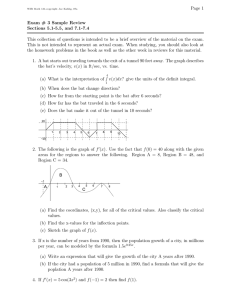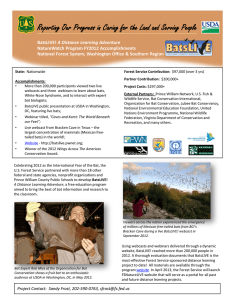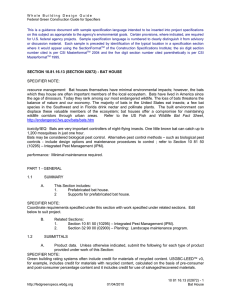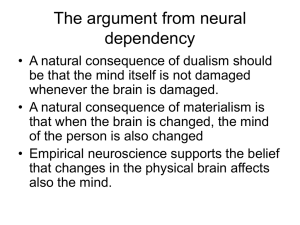Document 12043336
advertisement
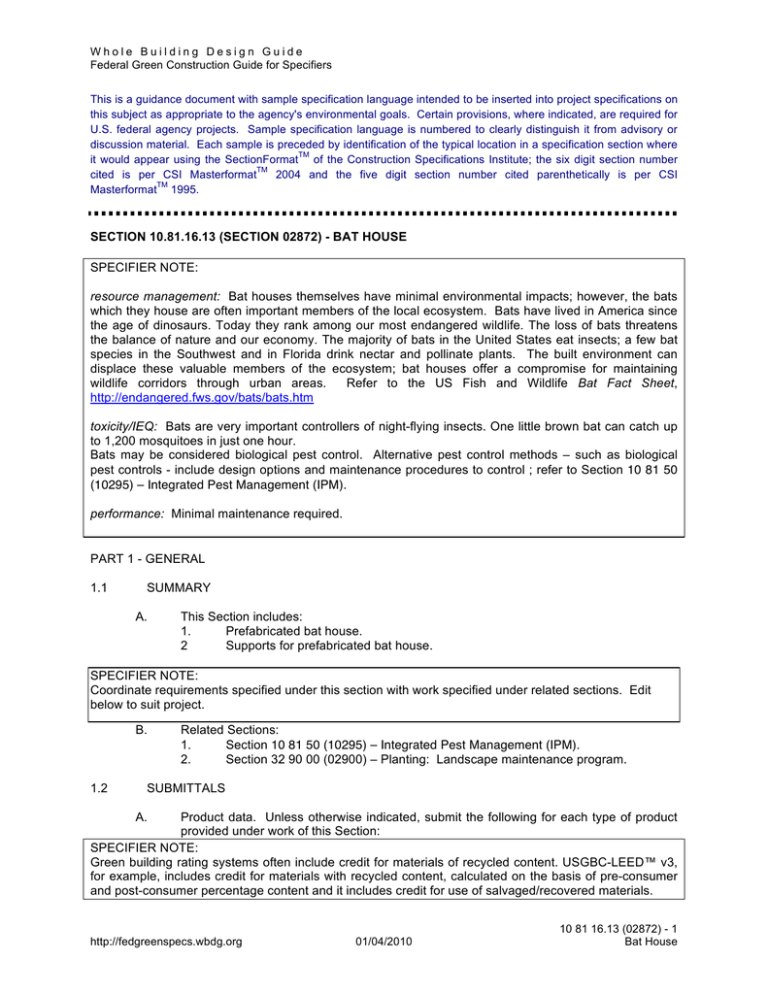
Whole Building Design Guide Federal Green Construction Guide for Specifiers This is a guidance document with sample specification language intended to be inserted into project specifications on this subject as appropriate to the agency's environmental goals. Certain provisions, where indicated, are required for U.S. federal agency projects. Sample specification language is numbered to clearly distinguish it from advisory or discussion material. Each sample is preceded by identification of the typical location in a specification section where TM it would appear using the SectionFormat of the Construction Specifications Institute; the six digit section number TM cited is per CSI Masterformat 2004 and the five digit section number cited parenthetically is per CSI TM Masterformat 1995. SECTION 10.81.16.13 (SECTION 02872) - BAT HOUSE SPECIFIER NOTE: resource management: Bat houses themselves have minimal environmental impacts; however, the bats which they house are often important members of the local ecosystem. Bats have lived in America since the age of dinosaurs. Today they rank among our most endangered wildlife. The loss of bats threatens the balance of nature and our economy. The majority of bats in the United States eat insects; a few bat species in the Southwest and in Florida drink nectar and pollinate plants. The built environment can displace these valuable members of the ecosystem; bat houses offer a compromise for maintaining wildlife corridors through urban areas. Refer to the US Fish and Wildlife Bat Fact Sheet, http://endangered.fws.gov/bats/bats.htm toxicity/IEQ: Bats are very important controllers of night-flying insects. One little brown bat can catch up to 1,200 mosquitoes in just one hour. Bats may be considered biological pest control. Alternative pest control methods – such as biological pest controls - include design options and maintenance procedures to control ; refer to Section 10 81 50 (10295) – Integrated Pest Management (IPM). performance: Minimal maintenance required. PART 1 - GENERAL 1.1 SUMMARY A. This Section includes: 1. Prefabricated bat house. 2 Supports for prefabricated bat house. SPECIFIER NOTE: Coordinate requirements specified under this section with work specified under related sections. Edit below to suit project. B. 1.2 Related Sections: 1. Section 10 81 50 (10295) – Integrated Pest Management (IPM). 2. Section 32 90 00 (02900) – Planting: Landscape maintenance program. SUBMITTALS A. Product data. Unless otherwise indicated, submit the following for each type of product provided under work of this Section: SPECIFIER NOTE: Green building rating systems often include credit for materials of recycled content. USGBC-LEED™ v3, for example, includes credit for materials with recycled content, calculated on the basis of pre-consumer and post-consumer percentage content and it includes credit for use of salvaged/recovered materials. http://fedgreenspecs.wbdg.org 01/04/2010 10 81 16.13 (02872) - 1 Bat House Whole Building Design Guide Federal Green Construction Guide for Specifiers Green Globes US also provides points for reused building materials and components and for building materials with recycled content. 1. Recycled Content: a. Indicate recycled content; indicate percentage of pre-consumer and postconsumer recycled content per unit of product. b. Indicate relative dollar value of recycled content product to total dollar value of product included in project. c. If recycled content product is part of an assembly, indicate the percentage of recycled content product in the assembly by weight. d. If recycled content product is part of an assembly, indicate relative dollar value of recycled content product to total dollar value of assembly. SPECIFIER NOTE: Specifying local materials may help minimize transportation impacts; however it may not have a significant impact on reducing the overall embodied energy of a building material because of efficiencies of scale in some modes of transportation. Green building rating systems frequently include credit for local materials. Transportation impacts include: fossil fuel consumption, air pollution, and labor. USGBC-LEED™ v3, for example, includes credits for materials extracted/harvested and manufactured within a 500 mile radius from the project site. Green Globes US also provides points for materials that are locally manufactured. 2. Local/Regional Materials: a. Sourcing location(s): Indicate location of extraction, harvesting, and recovery; indicate distance between extraction, harvesting, and recovery and the project site. b. Manufacturing location(s): Indicate location of manufacturing facility; indicate distance between manufacturing facility and the project site. c. Product Value: Indicate dollar value of product containing local/regional materials; include materials cost only. d. Product Component(s) Value: Where product components are sourced or manufactured in separate locations, provide location information for each component. Indicate the percentage by weight of each component per unit of product. 3. Documentation that bat houses are “Bat Approved” by Bat Conservation International. SPECIFIER NOTE: Green building rating systems typically include credit for sustainably harvested wood. USGBC-LEED™ v3, for example, includes credit for use of sustainably harvested wood certified under Forest Stewardship Council Guidelines. Under LEED™ v3, a minimum of 50 percent of wood-based materials and products incorporated into the Project must be certified in accordance with the Forest Stewardship Council Guidelines. . Green Globes US also provides points for wood products that originate from certified sources, such as, Forest Stewardship Council, Sustainable Forestry Initiative, and the CSA Sustainable Forest Management Program. B. Letter of Certification(s) for Sustainable Forestry: 1. Forest Stewardship Council (FSC): Provide letter of certification signed by lumber supplier. Indicate compliance with FSC "Principles for Natural Forest Management" and identify certifying organization. a. Submit FSC certification numbers; identify each certified product on a line-item basis. b. Submit copies of invoices bearing the FSC certification numbers. http://fedgreenspecs.wbdg.org 01/04/2010 10 81 16.13 (02872) - 2 Bat House Whole Building Design Guide Federal Green Construction Guide for Specifiers 2. 3. C. 1.3 Sustainable Forestry Board: Provide letter of certification signed by lumber supplier. Indicate compliance with the Sustainable Forestry Board’s "Sustainable Forestry Initiative" (SFI) and identify certifying organization. a. Submit SFI certification numbers; identify each certified product on a line-item basis. b. Submit copies of invoices bearing the SFI certification numbers. Canadian Standards Association (CSA): Provide letter of certification signed by lumber supplier. Indicate compliance with the CSA and identify certifying organization. a. Submit CSA certification numbers; identify each certified product on a line-item basis. b. Submit copies of invoices bearing the CSA certification numbers. Operating and Maintenance Manuals Submittals: 1. Submit maintenance instructions and procedures including but not limited to the following: a. Protection of bats from predators. b. Temperature requirements. c. Colonization expectations. d. Basic bat behavior and housing requirements. QUALITY ASSURANCE SPECIFIER NOTE: House must ‘set-in’ before bats will adopt it. Prime colonization time is spring. A. Schedule installation at start of construction period. B. Coordinate with work of Section 10 81 50 (10295) – Integrated Pest Management (IPM). PART 2 - PRODUCTS SPECIFIER NOTE: EO 13423 includes requirements for Federal Agencies to use “sustainable environmental practices, including acquisition of biobased, environmentally preferable, energy-efficient, water-efficient, and recycled-content products” Specifically, under the Sustainable Building requirements per Guiding Principle #5 Reduce Environmental Impact of Materials, EO13423 directs Federal agencies to “use products meeting or exceeding EPA's recycled content recommendations” for EPA-designated products and for other products to “use materials with recycled content such that the sum of post-consumer recycled content plus one-half of the preconsumer content constitutes at least 10% (based on cost) of the total value of the materials in the project.” Executive Order 13514; Federal Leadership in Environmental, Energy, and Economic Performance; was signed on October 5, 2009. http://www.ofee.gov/execorders.asp It expands upon the environmental performance requirements of EO 13423. http://www1.eere.energy.gov/femp/regulations/printable_versions/eo13423.html EO 13514 sets numerous federal requirements in several areas, including sustainable buildings and communities. Federal agencies must implement high performance sustainable federal building design, construction, operation and management, maintenance, and deconstruction, including: • Ensuring all new Federal buildings, entering the design phase in 2020 or later, are designed to achieve zero net energy by 2030. • Ensuring all new construction, major renovations, or repair or alteration of Federal buildings comply with the Guiding Principles of Federal Leadership in High Performance and Sustainable Buildings http://www1.eere.energy.gov/femp/pdfs/mouhighperfsustainfedfacs.pdf http://fedgreenspecs.wbdg.org 01/04/2010 10 81 16.13 (02872) - 3 Bat House Whole Building Design Guide Federal Green Construction Guide for Specifiers • 2.1 Ensuring at least 15% of existing agency buildings and leases (above 5,000 gross square feet) meet the Guiding Principles by fiscal year 2015 and that the agency makes annual progress towards 100% compliance across its building inventory. BAT HOUSE A. Prefabricated Bat House: “Bat Approved” by Bat Conservation International. Four chamber house. Approximately 30 inches tall by 14 inches wide by 7 inches deep. Construct from untreated wood or plastic. Seal all seams with silicone sealant. Screws, staples, nails, mounting hardware, and other sharp objects (including splinters) shall not protrude into roost chambers. 1. Chambers: Divide the inside of the house into chambers, minimum 2 and maximum 4 chambers. Space chambers so that they are 3/4 to 1 inch front to back. Roughen minimum one surface of each chamber; metal mesh, hardware cloth, and aluminum window screen is not acceptable. Scratch or groove wood surfaces horizontally, at 1/4- to 1/2-inch intervals; or cover with durable square, plastic 1/8 or 1/4 inch mesh. 2. Landing Area: 6 inch wide, extending below the entrance. Provide a rough surface; metal mesh, hardware cloth, and aluminum window screen is not acceptable. Scratch or groove wood surfaces horizontally, at 1/4- to 1/2-inch intervals; or cover with durable square, plastic 1/8 or 1/4 inch mesh. 3. Ventilation Slots: Provide a 1/2 inch wide ventilation slot across the front of the house 6 inches from the bottom. Provide a vertical 1/2 inch wide ventilation slot, 6 inches long, in each side of the rear chamber. SPECIFIER NOTE: Finish exterior black where average high temperatures in July are less than 85º F, dark colors (such as dark brown or dark gray) where they are 85 to 95° F, medium colors where they are 95 to 100º F and white or light colors where they exceed 100º F. Much depends upon amount of sun exposure; adjust to darker colors for less sun. Refer to Bat Conservation International for additional information. http://www.batcon.org/ 4. Finish: Wood: a. Exterior: Three coats of exterior grade, water-based paint or stain. [black] [dark brown] [dark gray] [Manufacturer’s standard dark colored factory finish.] [Manufacturer’s standard light colored factory finish.] b. Interior: Two coats dark, exterior grade, water-based stain. Apply stain after creating scratches or grooves or prior to stapling plastic mesh. 5. 6. 2.2 Attic: Provide attic space sealed off from the main living chamber. Roof: Sloped for positive drainage and shingled. ACCESSORIES SPECIFIER NOTE: Below describes support for freestanding installation. If installation will be attached to vertical surface of project, modify as necessary. A. Support: Fabricated from [Rot and Insect Resistant Wood Lumber as specified in Section 06 05 73 (06070) – Wood Treatment] [metal] [xxxxx]. Dimensions as recommended by prefabricated bat house manufacturer, but not less than 15 feet above grade. 1. Drainage material: Crushed rock and sand as specified in Division 31 (2), Earthwork. 2. Concrete: As specified in Division 03 (3), Concrete. http://fedgreenspecs.wbdg.org 01/04/2010 10 81 16.13 (02872) - 4 Bat House Whole Building Design Guide Federal Green Construction Guide for Specifiers 3. Hardware: Provide miscellaneous fasteners, anchors, and hardware as required for a complete installation. PART 3 - EXECUTION 3.1 INSTALLATION A. Supports: Install supports as recommended by bat house manufacturer and as follows: 1. Install at edge of wooded area. Orient such that house will receive sunlight during morning and early afternoon and is shaded from late afternoon sun. 2. Install supports minimum 4 feet below grade on crushed gravel drainage bed. Concrete minimum 4 inches around each support. Slope top of concrete away from post for positive drainage. B. Bat Houses: Mount on supports as recommended by bat house manufacturer and as follows: 1. Do not mount on trees. 2. Mount minimum 15 feet above grade. END OF SECTION http://fedgreenspecs.wbdg.org 01/04/2010 10 81 16.13 (02872) - 5 Bat House


